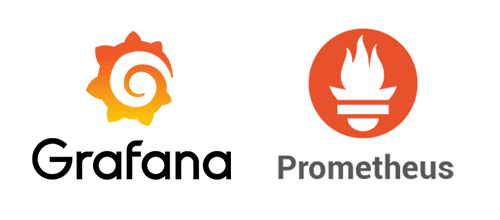Prometheus is an open-source systems monitoring and alerting toolkit designed primarily for reliability and scalability. It is used to collect metrics from applications and infrastructure, store them efficiently, and provide powerful query capabilities to analyze the data. Prometheus is widely adopted in the cloud-native ecosystem and is known for its ability to monitor dynamic environments such as Kubernetes.
Key Features of Prometheus:
Time-Series Data Storage:
- Prometheus stores metrics as time-series data, meaning each piece of data is associated with a timestamp. It collects numeric data, such as CPU usage, memory consumption, and request durations, and stores these metrics over time.
Pull-Based Metric Collection:
- Prometheus operates on a pull model where it actively scrapes metrics from monitored systems or applications at regular intervals via HTTP endpoints. Each service exposes its metrics at a
/metricsendpoint, which Prometheus scrapes.
PromQL (Prometheus Query Language):
- Prometheus includes a powerful query language called PromQL that allows users to aggregate, slice, and analyze metrics. PromQL is designed for flexible queries that can generate graphs, tables, and alerts based on the collected data.
Alerting:
- Prometheus has a built-in alerting mechanism. Users can define alerting rules using PromQL, and when these rules are triggered, Prometheus sends alerts to an Alertmanager. The Alertmanager then handles the routing and notification of alerts (e.g., via email, Slack, or other channels).
Multi-Dimensional Data:
- Prometheus allows metrics to have labels, which are key-value pairs that provide additional context to a metric. For example, a metric for HTTP requests might have labels like
method="GET"andstatus="200", allowing for detailed filtering and analysis.
No Dependency on Distributed Storage:
- Prometheus is designed to be a standalone service that doesn’t rely on external distributed storage. Instead, it stores data locally on disk, which makes it easier to set up and operate. However, it also supports integrations with long-term storage systems for persistence and querying of historical data.
Service Discovery:
- Prometheus has built-in support for service discovery, allowing it to automatically discover targets in dynamic environments such as Kubernetes, Consul, AWS EC2, or GCP. This makes it highly effective for monitoring modern cloud-native applications where services frequently change.
Modular Architecture:
- Prometheus is designed as a modular system. It consists of the Prometheus server for data collection and querying, the Alertmanager for handling alerts, and exporters for collecting metrics from third-party services and systems.
Grafana Integration:
- Prometheus integrates well with Grafana, a popular open-source visualization tool. Grafana allows users to create custom dashboards that display real-time metrics collected by Prometheus, providing visual insights into the performance of applications and infrastructure.
Components of Prometheus:
Prometheus Server:
- The core component of the Prometheus ecosystem, responsible for scraping metrics, storing time-series data, and providing a query interface through PromQL.
Exporters:
- Exporters are components that expose metrics from third-party systems or services in a format that Prometheus can scrape. For example:
- Node Exporter: Collects metrics from Linux/Unix system resources (CPU, memory, disk, etc.).
- Blackbox Exporter: Probes endpoints such as HTTP, TCP, DNS, and ICMP.
- Database Exporters: Collect metrics from databases like MySQL, PostgreSQL, etc.
Alertmanager:
- The Alertmanager handles alerts generated by Prometheus’ alerting rules. It manages alert deduplication, grouping, routing, and notifications. Alerts can be sent to services like Slack, PagerDuty, email, or custom webhooks.
Pushgateway:
- The Pushgateway is used to push metrics from short-lived jobs (e.g., batch jobs) to Prometheus, as these jobs may not be running long enough for Prometheus to scrape them directly.
Prometheus Client Libraries:
- Prometheus provides libraries for various programming languages (e.g., Go, Java, Python, Ruby) that developers can use to instrument their applications and expose custom metrics for Prometheus to scrape.
Prometheus Use Cases:
Infrastructure Monitoring:
- Prometheus is widely used to monitor infrastructure components, including servers, virtual machines, containers, and network devices. Metrics such as CPU usage, memory consumption, disk I/O, and network throughput can be monitored in real time.
Application Performance Monitoring (APM):
- Prometheus collects metrics from applications to monitor performance metrics like request rates, error rates, and response times. These metrics help developers understand application behavior and troubleshoot issues.
Kubernetes Monitoring:
- Prometheus is commonly used for monitoring Kubernetes clusters. It scrapes metrics from Kubernetes components (nodes, pods, services) and applications running within the cluster, providing deep visibility into cluster health and resource usage.
Service-Level Monitoring and Alerts:
- Prometheus can be used to monitor Service-Level Indicators (SLIs) and Service-Level Objectives (SLOs). It generates alerts when thresholds are breached, ensuring that teams are notified of potential issues before they impact users.
Microservices Monitoring:
- In microservices architectures, Prometheus can monitor individual services by collecting metrics like request latencies, error counts, and throughput. With its labeling system, Prometheus allows teams to analyze metrics at a granular level (e.g., by service, endpoint, method).
Example Prometheus Workflow:
Instrumenting the Application:
- Developers use a Prometheus client library to instrument their application, exposing metrics like
http_requests_totalandresponse_time_seconds.
Prometheus Scrapes Metrics:
- Prometheus is configured to scrape the application’s
/metricsendpoint every 15 seconds to collect the time-series data.
Store and Query Metrics:
- Prometheus stores the scraped metrics in its local time-series database. Using PromQL, developers can query these metrics to analyze trends, create alerts, or visualize data in Grafana.
Alerting:
- Prometheus evaluates alerting rules based on metric thresholds (e.g., high error rates or latency spikes) and sends the triggered alerts to the Alertmanager.
Visualizing Metrics:
- Grafana is used to create dashboards that visualize metrics, helping teams monitor system health and performance in real time.
Prometheus Metrics Example:
Here is an example of how a custom metric might be exposed by an application using the Prometheus client library:
package main
import (
"net/http"
"github.com/prometheus/client_golang/prometheus"
"github.com/prometheus/client_golang/prometheus/promhttp"
)
var (
requestCount = prometheus.NewCounterVec(
prometheus.CounterOpts{
Name: "http_requests_total",
Help: "Total number of HTTP requests",
},
[]string{"method", "status"},
)
)
func init() {
prometheus.MustRegister(requestCount)
}
func handler(w http.ResponseWriter, r *http.Request) {
requestCount.With(prometheus.Labels{"method": r.Method, "status": "200"}).Inc()
w.Write([]byte("Hello, Prometheus!"))
}
func main() {
http.Handle("/metrics", promhttp.Handler())
http.HandleFunc("/", handler)
http.ListenAndServe(":8080", nil)
}Prometheus Query Example (PromQL):
- To retrieve the total number of HTTP requests over the past 5 minutes:
sum(rate(http_requests_total[5m]))- To alert when the error rate exceeds 5% of the total requests:
(sum(rate(http_requests_total{status="500"}[5m])) / sum(rate(http_requests_total[5m]))) > 0.05Prometheus Architecture:
Prometheus Server:
- The Prometheus server scrapes metrics, stores them in a time-series database, and allows querying of the data.
Targets:
- These are the applications and services that expose metrics via HTTP endpoints. Prometheus scrapes these endpoints to collect data.
Alertmanager:
- Alerts are routed to the Alertmanager, which handles notifications and alert grouping.
Visualization Tools:
- Tools like Grafana or Prometheus’s built-in graphing interface allow users to visualize metrics in dashboards or graphs.
Advantages of Prometheus:
Scalable:
- Prometheus is designed to scale, especially in dynamic environments like Kubernetes, making it ideal for monitoring microservices and large clusters.
Powerful Query Language:
- PromQL provides flexible and powerful query capabilities for analyzing and aggregating time-series metrics.
Wide Ecosystem:
- Prometheus has a wide range of integrations and exporters, enabling it to monitor almost any type of system, service, or application.
Built for Reliability:
- Prometheus is a self-contained, standalone service with no external dependencies, making it robust and easy to deploy.
Disadvantages of Prometheus:
Limited Long-Term Storage:
- Prometheus stores data locally, which can be a limitation for long-term retention. However, external storage systems (e.g., Thanos, Cortex) can be integrated for long-term storage.
No High Availability by Default:
- Prometheus does not provide built-in support for high availability (HA). Achieving HA requires setting up multiple Prometheus instances and managing redundancy manually.
Conclusion:
Prometheus is a powerful, scalable, and flexible monitoring and alerting toolkit, especially suited for cloud-native and containerized environments like Kubernetes. It is highly extensible through exporters and integrations, and its query language, PromQL, enables sophisticated analysis of metrics data. Prometheus has become a cornerstone of modern monitoring systems and is widely used in DevOps and SRE practices for real-time system observability.



